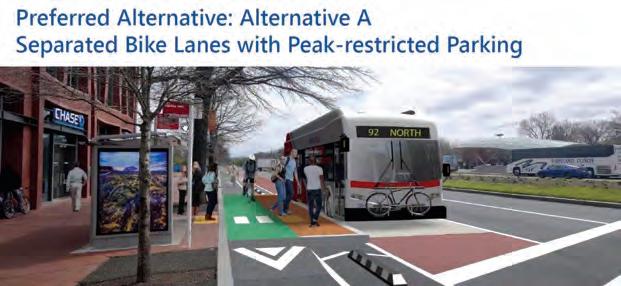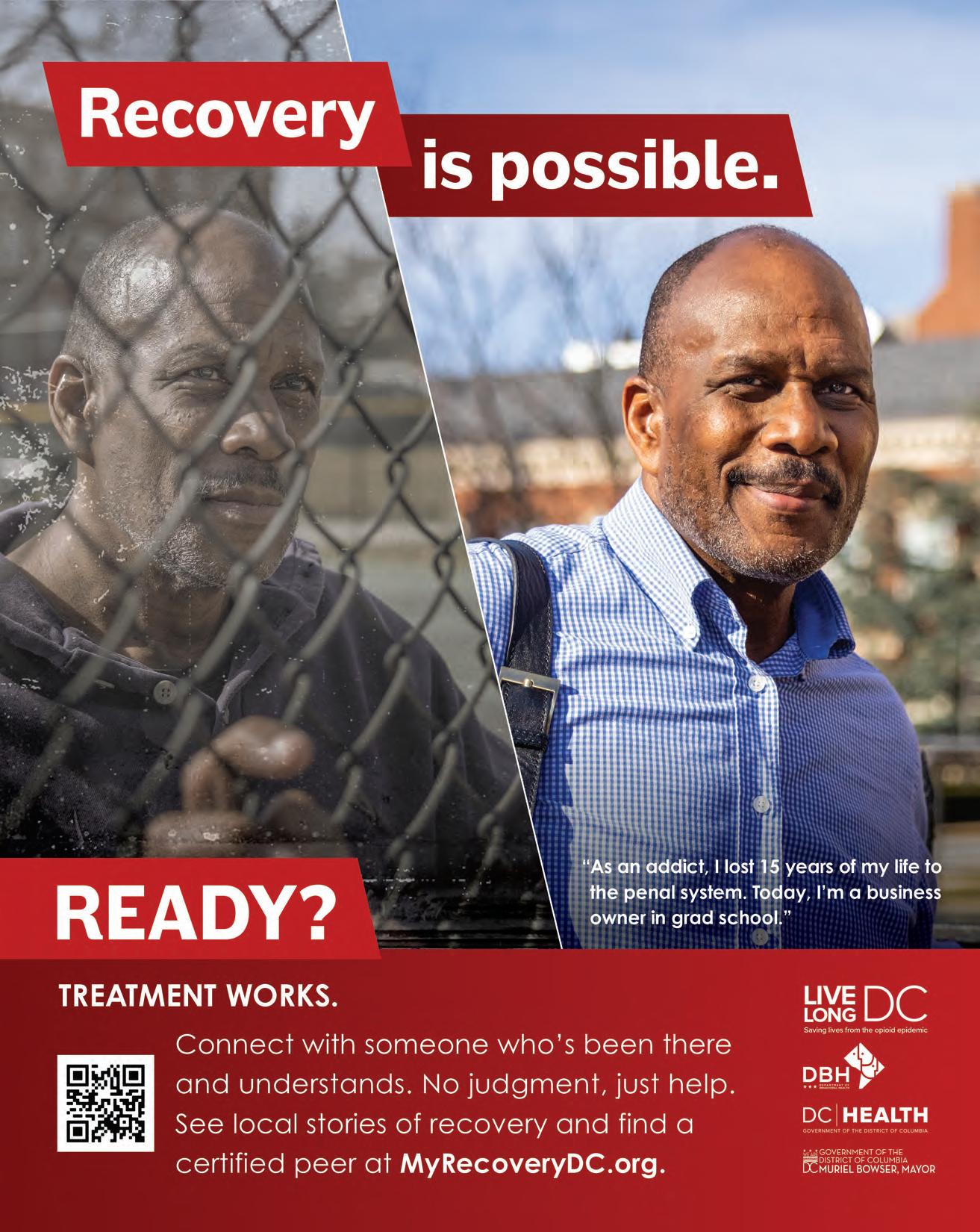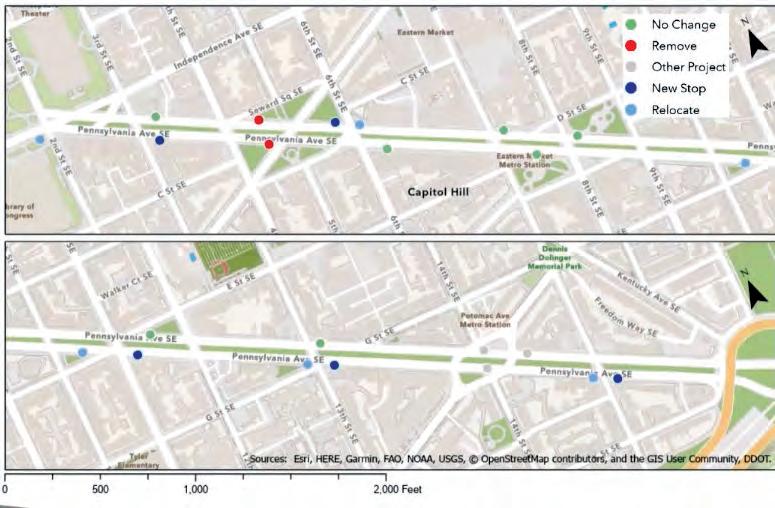
6 minute read
Change Comes to Pennsylvania Avenue in June – Designed to Improve Roadway Mobility, Safety for All by Elizabeth O’Gorek
CHANGE COMES TO PENNSYLVANIA AVENUE IN JUNE
Designed to Improve Roadway Mobility, Safety for All
by Elizabeth O’Gorek
In June 2022, the District Department of Transportation (DDOT) will begin construction on the Pennsylvania Avenue SE Corridor from Second Street SE to 13th Street SE.
This first phase of the project is coordinated to begin at the conclusion of work on the ongoing streetlight and traffic signal upgrade project. Work on Phase II, focused on Pennsylvania Avenue from 13th Street SE to Barney Circle is slated to begin once the Potomac-Pennsylvania Intersection Project is complete.
Aside from being a primary route to the I-295 and Capital Beltway, Pennsylvania Avenue SE provides key bus, bicycle and pedestrian connection to downtown and communities to the east and south. It’s also a Capitol Hill commerce hub, home to many Hill restaurants, services and retail outlets.
But Pennsylvania Avenue, which sees upwards of 30,000 vehicles a day, is considered to be an uncomfortable route for even the most confident of cyclists. It is rated at the highest Level of Traffic Stress (LTS), level 4. “Anyone who has ridden the bicycle on the corridor can attest that it is certainly not for the faint of heart,” Project Manager Greg Matlesky said in an early virtual presentation on the project.
The changes to Pennsylvania Avenue are intended to provide safer mobility options for all users. They do so by reducing speed limits from 30 mph to 25 mph and by providing separated bike and priority bus lanes, all with the intention of a minimal impact on traffic flow and parking availability.
In 2014, the MOVE DC plan recommenced protected bike lanes be added to Pennsylvania Avenue SE. The project was introduced at public meetings in 2016 and has been consistently supported by Advisory Neighborhood Commission (ANC) 6B, in whose boundaries the project is located. A design was selected in Summer 2020 after DDOT received hundreds of public comments.
Changing Streetscape
The design will reduce dedicated traffic lanes on Pennsylvania Ave. to two in either direction. Bike lanes will be located along both curbs, separated from vehicular traffic by a 3 feet space occupied by Flexi-posts interspersed with concrete barriers.
In between the barriers and the travel lanes, one lane from the 200 to 1200 blocks of Pennsyl-
vania Avenue will be used for parking except during peak traffic hours, when they will become bus priority lanes. Priority lanes will be in effect Monday through Fridays, except holidays. During the morning rush the north side will become a dedicated westbound bus lane from 7:00 a.m. through 9:30 a.m. In the afternoon, the south side or eastbound lane next to the bike lane will be bus priority from 3:30 p.m. to 7 p.m. Design ‘Alternative A’, was selected for work on Pennsylvania Avenue SE in June 2020 after more than 250 people wrote in support of the new configuration. Detail: DDOT will create shared bus DDOT presentation, July 2020/Facebook platforms that allow for ease of boarding. The bike lane created adjacent to the curb, will be raised near bus stops to curb level. Shared platforms will be located on the 300, 500, 600, 700, 1100, and 1300 blocks of Pennsylvania Avenue SE. While parking will be permitted on the south side during morning commute and on the north side in the afternoon, meter parking will remain on both sides when parking is permitted. Residential Permit Parking (RPP) will be preserved where it exists on the eastern end of the corridor. Loading zones are a part of the plan, Project Manager Greg Matlesky told a meeting of ANC 6B. For instance, a pickup and drop off area is planned for the area in front of 650 Pennsylvania Ave. SE. Loading zones will be adjusted along the corridor to bring them to a standard 40-foot length, adding some at the end of blocks to allow for ‘head-in/backin loading’ rather than from travel lane. These plans were developed with input from the BIDs and Main Streets, as well as additional businesses along the corridor, Matlesky added.
Shared platforms in new bike lanes adjacent to the curb will be located near bus stops for ease of Bus Stop Changes
boarding. Screenshot: DDOT ANC 6B Presentation, April 6, 2022. Some bus stops will be relo-


cated along Pennsylvania Avenue. Two will be removed completely, both from the 400 block of Seward Square SE, in order to balance bus stop spacing for transit efficiency. Currently, there are three bus stops within that two block area.
For safety reasons, some bus stops are being relocated across streets, so that buses will stop on the far sides of intersections. Matlesky told ANC 6B that drivers tend to make left turns around buses despite a lack of visibility, endangering pedestrians and cyclists potentially riding in the curb-adjacent bike lane, so DDOT tries to make these relocations where possible.
DDOT Transportation Planner Kevin Harrison said the biggest challenge DDOT has faced with priority lanes is with stopping violations. Beginning, in 2022 buses will have cameras performing automatic traffic enforcement, issuing traffic tickets for cars parked in bus lanes and at bus stops throughout the District.
Overall, however, indications are that bus lanes increase transit speeds, Harrison said. While there have been challenges to evaluation posed by irregular traffic during the pandemic, where they have been able to make good determinations, indications are that dedicated bus lanes lead to significant improvements in bus travel time.
Timeline
Work on the elevated bus platforms is slated to start in June. That work should take up about 30 days; in July or August, when the streetlight project winds down, DDOT will begin milling,
or removal of the surface concrete layers, and then repaving of Pennsylvania Avenue from Second through 13th Streets SE before painting bus and bike lanes along the corridor. After that, barriers will be installed for bike and bus lanes. Most of the corridor work, including construction, striping and signals will be done Several bus stops will be relocated as part of the project. DDOT ANC 6B by fall 2022, Matlesky Presentation, April 6, 2022. Photo: The current configuration of Pennsyl- said. However, bicycle vania Avenue SE is rated as “highly stressful” for cyclists. E.O’Gorek/CCN signals are slated to be installed at five intersections along the corridor; due to COVID-19 related supply chain issues, delivery of the equipment is delayed. That will leave a few issues with right and left turn conflicts for cyclists that will be mitigated by the signal installation. That means the signal work may not be complete until Spring 2023.
Next Step: Phase II
The project is intended to remake mobility from the Capitol Building all the way to the Anacostia River. However, it is broken into two phases in coordination with the team working on the renovation of the Pennsylvania and Potomac Avenue intersection. Coordination is ongoing, Hamilton added, and once the intersection is complete, “it should just be a matter of coming in and installing the hardware and the striping,” Hamilton said. The intersection project has been decades in the making. With the Environmental Assessment winding down and a design plan in place, the project team is looking to get funded for construction in FY23. However, Matlesky said it could take from nine months to a year to secure a construction team, and another year or two to actually do the work. That means Phase II is unlikely to be implemented until 2024 or 2025. You can see the 100 percent designs at https://tinyurl.com/PennAveSE100 or visit the project website at www.pennavese.com u











